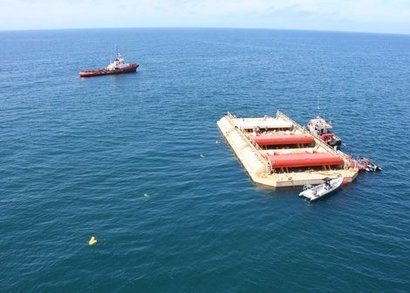
The new technology includes higher energy output, compact size and simple installation by a Spanish team from Proinsener Energía who built it based upon an Abengoa design specification. The substation, located on land, connects the WaveRoller device to the grid using transformers, frequency converters and other electrical components. Abeinsa Engineering has been responsible for the project coordination of the new substation’s detailed design and manufacturing.
“The previous substation used for project Surge (2012 – 2014) is replaced by an improved new substation with a higher rating, which is better suited for project deliveries and the maritime climate” said Jussi Åkerberg, CTO of AWE.
AWE has worked with an experienced supply base to build this First-of-a-Kind WaveRoller unit (FOAK). To ensure serial production capacity, AWE is expanding the development of its supply chain by supporting and advancing local production at WaveRoller project sites.
The supplier of the substation is Proinsener Energía. Abeinsa Engineering and Proinsener Energía are both Spanish companies.
AWE is now also sourcing new goods and service suppliers globally including steel works, castings, machining, bearings, hydraulic components, electrical components and several other procurement categories.
The company expects potential suppliers to support AWE to meet the cost-efficient and reliable ramp-up of WaveRoller production. Previous similar references from renewable energy, marine or offshore industry applications are a merit when considering the best suppliers for WaveRoller projects. Standard quality requirements are to be met by the supplier as are sufficient management systems certified by a reputable accreditation body.
The Surge2 project follows the successful Surge project, where AW-Energy demonstrated the technology with a grid connected device producing electricity to the Portuguese grid from a site fully exposed to the ocean storms.
This new project, Surge2, is also designated a FOAK (First of a Kind) project and has been designed to meet ESB’s WestWave requirements. Manufacturing of the main components for this new industry (begun in 2016) have been sourced globally – Canada, Finland, Italy, Portugal, Spain, Turkey and the UK. The main subsystems are the foundation, power take off, panel and panel bearings. The project was financed by AW-Energy and a loan from Business Finland.
The WaveRoller is a device that converts ocean wave energy to electricity. The machine operates in near-shore areas (approximately 0.3-2 km from the shore) at depths of between 8 and 20 meters. Depending on tidal conditions it is mostly or fully submerged and fixed to the seabed. A single WaveRoller unit (one panel and PTO combination) is rated at between 350kW and 1000kW, with a capacity factor of 25-50 percent depending on wave conditions at the project site. The technology can be deployed as single units or in farms.
Manufacturing of the main components of the WaveRoller have been sourced in Canada, Finland, Italy, Portugal, Spain, Turkey and UK. The WaveRoller technology provides three unique proven benefits:
The WaveRoller is installed and operating in the nearshore area with easy access to the site, protected from extreme conditions with a minimised balance of plant infrastructure cost. It captures power with a bottom fixed panel (oscillating wave surge converter) – this highly efficient power capture can operate in low to mid and high-sea states with no cut-off and with only one moving part. The device also converts movement to electricity using an onboard power storage and hydraulic system utilising a smooth and grid-compatible power output, the ability to establish and support the grid and a low maintenance design with an onshore substation.
For additional information:

